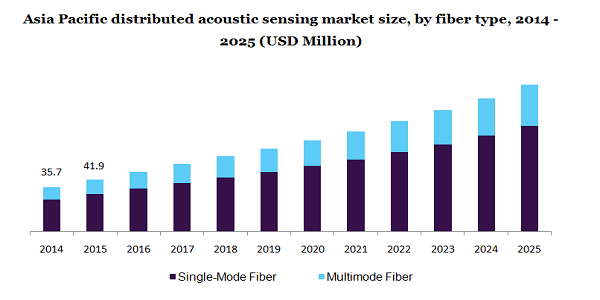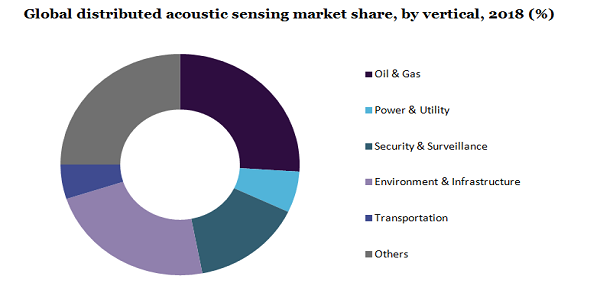- US: +1-408-610-2300
- Toll Free: +1-866-831-4085
- Become a Client
The global distributed acoustic sensing market size was valued at USD 360.8 million in 2018. It is projected to witness a CAGR of 11.5% CAGR over the forecasted years, 2019 to 2025. The shifting trend towards the adoption of passive sensing methods for the detection of sound signals is projected to drive market growth in the upcoming years. Also, the advantages of DAS (Distributed Acoustic Sensing) over conventional systems like the ease of installation, low costs, and thin cables are further anticipated to fuel the market growth.
The DAS system can help in measuring the vertical depth of the well without disturbing the fluid. These systems are based on fiber optics and can be used in downstream, midstream, and upstream applications across the oil & gas industry. They are also using enhanced bandwidth telecommunications and infrastructure to the SCADA controls. Moreover, their usage for sensing pressure, strains, and temperature are gaining traction across the majority of subsea pipelines and downhole strains.

The DAS system was majorly used across the defense and border security sector due to its feature of real-time monitoring and detection of intrusions. But, nowadays, they are widely used in oilfields to detect and monitor good operations. Their feature for detecting external interference and leakages is also gaining traction across the globe.
These systems have also replaced the conventional tools for production logging to measure flow injection and downhole production. It makes use of a detection technique named digital optoelectronics that can acquire amplitude and phase from the generated sound waves across the wellbore.
The global distributed acoustic sensing (DAS) market can be classified into multimode fiber and single-mode fiber based on fiber type. The segment of single-mode fiber is projected to register a significant share across the global market, in 2018. This can be associated with their feature of allowing limited external interference. It also features a reduction in light scattering and waste, thereby increasing the data transmission.
These fibers are thinner than the multimode ones which facilitate their usage in applications of in-well monitoring. Further, their usage in long-range applications is gaining traction on account of the increased capacity of bandwidth. But these single-mode fibers are costlier than the multimode fibers. However, their enhanced intrusion detection efficiency and a wide range of applications are projected to drive market growth.
The global market can be classified into power & utility, oil & gas, environment & infrastructure, transportation, security & surveillance, and others based on vertical type. In 2018, the oil & gas segment held the largest share across the global market. This can be associated with their surging usage for flow monitoring, pipeline monitoring, asset management, intrusion detection, and downhole good sensing. As the oilfield operations require more precision for monitoring and sensing, the market for DAS is anticipated to grow significantly across this segment.

These fiber optics are majorly used for long-distance data transfer. Rapid technological advances enabling the usage of DAS systems at high-pressure and temperature environments inside the borewells. Further, their potential for sensing vibrations is anticipated to drive the market demand in the upcoming years.
North America held the largest share of around 34.0% across the global market, in 2018. This can be attributed to the large presence of the oil & gas industry across this region. Further, exploration of shale gas being carried out across this region is projected to drive market growth.
Asia Pacific is projected to register the highest CAGR over the forecasted period, 2019 to 2025. This can be associated with the rising adoption of fiber optics across the telecommunication sector. Further, rapid technological advances across the healthcare industry are driving the need for DAS systems. Moreover, the imposition of government restrictions over the disposal of toxic waste is driving the need for pipeline management, thereby generating demand for DAS systems.
The global market for distributed acoustic sensing has been negatively affected on account of the ongoing COVID-19 pandemic. This can be associated with operational stagnancy across the oil & gas industry worldwide. Also, a reduction in demand for automotive fuels on account of travel restrictions, fluctuations in the petroleum prices, and restrictions over cargo movement across national and international borders are anticipated to hinder the market growth for oil and gas, thereby obstructing demand for DAS systems.
Also, the oil and gas exploration activities have been affected on account of lockdown imposition. The key players are also operating with a minimal workforce which is anticipated to merely satisfying the demand without attaining market growth. But, in the post-pandemic period, the demand for DAS systems is anticipated to boost due to rapid technological advances across this sector coupled with the increasing need for inspection and measurement of fluids.
The key players in the market are Halliburton; OptaSense; Baker Hughes; Schlumberger Limited; Northrop Grumman Corporation; Ziebel; and Omnisens, Silixa Ltd. They are engaged in expanding their customer base for gaining a competitive advantage. Also, strategies like partnerships, collaborations, mergers, and acquisitions are being undertaken by these players for widening their global reach.
For example, Halliburton came up with an agreement with ARTC (Advanced Remanufacturing & Technology Center) in 2019 to gain anchor membership. This membership can facilitate Halliburton to implement advanced technologies in their R&D projects.
|
Attribute |
Details |
|
The base year for estimation |
2018 |
|
Actual estimates/Historical data |
2014 - 2017 |
|
Forecast period |
2019 - 2025 |
|
Market representation |
Revenue in USD Million and CAGR from 2019 to 2025 |
|
Regional Scope |
North America, Europe, Asia Pacific, South America, MEA |
|
Country Scope |
U.S., Canada, Mexico, Germany, U.K., France, China, Japan, India, and Brazil |
|
Report coverage |
Revenue forecast, competitive landscape, growth factors, and trends |
|
15% free customization scope (equivalent to 5 analyst working days) |
If you need specific information, which is not currently within the scope of the report, we will provide it to you as a part of the customization |
This report forecasts revenue growth at the global, regional, and country levels and provides an analysis of the latest industry trends from 2014 to 2025 in each of the sub-segments. For the purpose of this study, Million Insights has segmented the global distributed acoustic sensing market on the basis of fiber type, vertical, and region:
• Fiber Type (Revenue, USD Million, 2014 - 2025)
• Single-mode Fiber
• Multimode Fiber
• Vertical (Revenue, USD Million, 2014 - 2025)
• Oil & Gas
• Power & Utility
• Security & Surveillance
• Environmental & Infrastructure
• Transportation
• Others
• Regional Outlook (Revenue, USD Million, 2014 - 2025)
• North America
• The U.S.
• Canada
• Mexico
• Europe
• The U.K.
• Germany
• France
• The Asia Pacific
• China
• Japan
• India
• South America
• Brazil
• Middle East & Africa


Research Support Specialist, USA